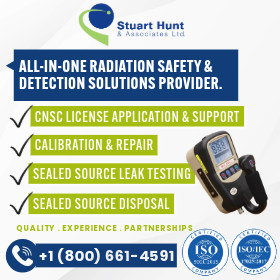ALARA – How Low Is Low Enough? Be Reasonable! / L’ALARA – Quel niveau est suffisamment faible? Il suffit d’être raisonnable!

Attendees at the second SFRP/IRPA workshop on reasonableness in the implementation of the ALARA principle, which took place in Paris, France, in October 2018. / Les participants au second atelier de la SFRP/IRPA portant sur le caractère raisonnable de la mise en application du principe ALARA, qui avait lieu à Paris, France, en octobre 2018.
Résumé
Avec la Société Française de radioprotection (SFRP), l’équivalent français de l’Association canadienne de la radioprotection, l’Association internationale pour la protection contre les radiations a coanimé deux ateliers sur la mise en pratique du principe ALARA. L’objectif principal était de répondre à la question que se pose tout professionnel de la radioprotection devant appliquer le principe ALARA de façon pratique : Quel niveau est suffisamment faible? Dans cet article, Stéphane Jean-François fait état des avantages d’être raisonnable.
“Be reasonable!” Say this title out loud using the same tone of voice a parent would use with an exasperating kid. I see you smiling a bit, even if you’re not a parent!
“Be reasonable” is a universal order, an ultimatum, or at the very least a strong recommendation. You’ve been there (you’ve either uttered or heard this statement), and you know exactly what it means—behave, calm down, lower your expectations.
Did you ever ask yourself if you’re worthy of the great responsibility associated with being reasonable? Whether you are a five-year-old waiting to arrive at your final destination (Are we there yet?) or a “grown-up” radiation safety professional who wants to reduce a dose “ALARA-style,” we are asking you to use “reason,” a major philosophical concept explored by Aristotle. Reason in philosophy is used to establish criteria for what is true or false, good or bad, or to implement programs to reach an objective. Wow! Reason is meant to establish criteria for good or bad . . . but there are no clear right or wrong answers where ALARA is concerned. No wonder we’re still debating what is “reasonable” more than 2,000 years after Aristotle!
The Société Française de radioprotection (SFRP), the French equivalent to the Canadian Radiation Protection Association, with the International Radiation Protection Association (IRPA), co-hosted two workshops on the practical implementation of the ALARA principle. A summary of these two workshops was presented at the Health Physics Society annual meeting, July 2019, in Orlando, FL, as part of the International Commission on Radiological Protection (ICRP)/International Radiation Protection Association (IRPA) special session on tolerance and reasonableness. But it all started two years ago.
In February 2017, an SFRP/IRPA workshop on reasonableness in the implementation of the ALARA principle in Paris, France, brought together about 30 attendees from radiation protection societies in Europe, Japan, and Korea, as well as international societies like the ICRP, World Health Organization (WHO), and IRPA. Their key objective was to answer the question we have all asked ourselves as radiation safety professionals dealing with ALARA in a practical way—How low is low enough?
The second SFRP/IRPA workshop on reasonableness in the implementation of the ALARA principle took place in Paris, France, in October 2018.
For both workshops, the approach was the same—attendees formed three teams representing three sectors:
- Nuclear industry
- Medical field
- Existing exposure situations (radon, radium cleanup, post-accident, etc.)
The focus of the first SFRP/IRPA workshop was on actual ALARA application, and a few common points united the three sectors: education, information, training, and building radiation protection culture through stakeholder involvement.
The second workshop used practical case studies to refine findings from the first workshop. As a participant and representative of our part of the world at the second SFRP/IRPA workshop, I would like to share a summary of the second workshop.
On the first day, Jean-François Lecomte (SFRP/Institute for Radiological Protection and Nuclear Safety {IRSN} representative) presented the results of the first workshop. Roger Coates (IRPA) and Bernard Le Guen (SFRP) introduced the goals and expectations of the second workshop. Then, nine practical cases (three cases per sector) were presented in a plenary session.
Our very own Manon Rouleau presented one of the three medical cases: “Province-wide dose optimisation in CT and PET-CT through a collaborative and multidisciplinary approach, in Canada.” She talked about the optimization of dose in imaging in Quebec through the collaboration of a multidisciplinary team. (This was also the topic of her well-received case presentation at the 2018 CRPA conference.)
The next day, we broke out into three working groups to discuss the case studies and, at the end of the day, summarize our discussions and recommendations to IRPA. Following is a summary of our discussions.
Nuclear Working Group
Chair: Caroline Schieber
Topics
- Replacement of heaters (France)
- Operation of nuclear plants (Spain)
- Operation of nuclear plants (United Kingdom)
Findings
- ALARA is a holistic approach.
- Optimization is based on experience.
- Stakeholder involvement is essential. We need more communication between industry and regulators.
- Education of workers and stakeholders is crucial.
- Optimization should find a balance between the different hazards.
Medical Working Group
Chair: Stéphane Jean-François
Topics
- Collaborative approach, dose and image (Canada)
- Operation of a public hospital (Greece)
- Image quality and dose (Italy)
Findings
- The tools used to establish reasonableness are training and radiation protection safety culture.
- We need to share the knowledge (IRPA, ICRP, WHO).
- We need to promote ALADA (as low as diagnostically achievable) with the equipment available; we can’t always have access to state-of-the-art technology (public sector).
- We need more awareness regarding medical ethics.
- We need to optimize using a multidisciplinary approach that involves patients.
Existing Exposure Situations Working Group
Chair: Amber Bannon
Topics
- Watch industry (Switzerland)
- Radon action plan (Czech Republic)
- Drinking water survey (Belgium)
Findings
- Public acceptance is required.
- The public accepts natural sources better than artificial sources.
- For pollution, there are no safe or acceptable levels.
- Peacetime should be used to inform the public before a crisis occurs.
- Authorities need to be clear about the rules (application, resources, etc.)
Some “avant-garde” radiation protection professionals may already know the variations of ALARA, where “reasonably” changes to account for the various stakeholders:
- ALAHA (holistically; nuclear)
- ALADA (diagnostically; medical)
- ALAQA (qualitatively, quality of life; post-accident)
- ALAThecA (technically; non-ionizing)
We can discuss reason here, but reason is not enough and we cannot discuss it alone. We also need to identify, engage, and empower targeted stakeholders.
Needless to say, optimization is a challenge in all sectors. This was restated as a common point in the conclusion of a presentation titled “IRPA/SFRP workshops on the practical implementation of the ALARA principle” that Jean-François Lecomte gave (based on the paper he coauthored with me, Thierry Schneider, Caroline Schieber, and Yann Billarand) at the 2019 HPS annual meeting in Orlando, FL. He said, “Optimization is a deliberative process to achieve a reasonable compromise with all informed stakeholders.”
So, CRPA members, how can we practically implement ALARA? Let’s discuss.
For our medical CRPA members, the American Association of Physicists in Medicine (AAPM) has started a conversation with an open letter to the imaging community in August 2019. The topic was the use of gonadal and fetal lead aprons for X-rays as good ALARA practice. In essence, AAPM says these aprons, once a mainstay for patient radiation protection, will no longer be used routinely as they provide negligible or no benefit to patient health.
According to AAPM, the practice (and in many cases, regulatory obligation) of using gonadal and fetal lead aprons for X-rays should now be thrown out. Hopefully all stakeholders will be informed and the discussion will include them; it’s always an important human issue to remove something that one would consider “protection.”
My reasonable two cents is this—we know shielding is useless for internal scattering and technology is evolving, but this letter does not mention justification and optimization. Shall we start there first?
Mom, Dad, more than ever I understand; being reasonable is not that easy!
Stéphane Jean-François
Stéphane Jean-François is a certified health physicist at Radioprotection Inc. Having studied engineering physics, he received his professional certification from the American Board of Health Physics in 1998 and has renewed that certification five times since. He has worked in the field of radiation protection for the past 28 years, including 25 years as radiation safety officer. He has been a CRPA member since 1996.
Stéphane Jean-François est spécialiste certifié en radioprotection à Radioprotection Inc. Ingénieur-physicien de formation, il a obtenu sa certification professionnelle en radioprotection auprès de l’American Board of Health Physics en 1998, certification renouvelée 5 fois depuis. Il compte 28 ans d’expérience dans le domaine pratique de la radioprotection, dont 25 ans comme RRP. Il est membre de l’ACRP depuis 1996.





